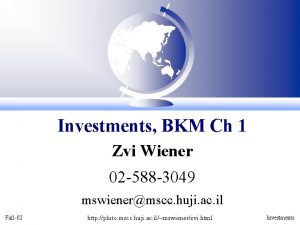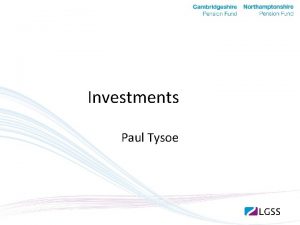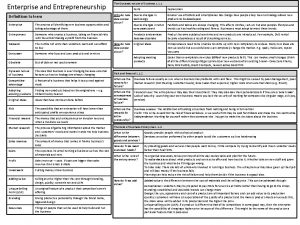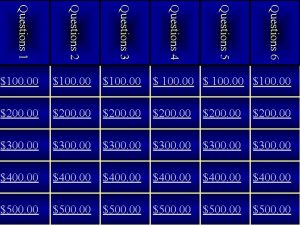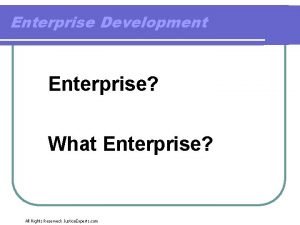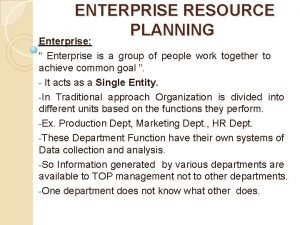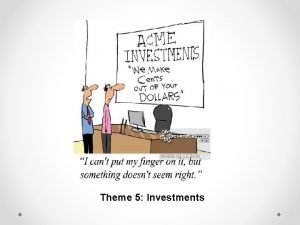INVESTMENTS OF THE ENTERPRISE QUESTIONS 1 Investments definitions
















































- Slides: 48

INVESTMENTS OF THE ENTERPRISE

QUESTIONS • 1. Investments: definitions • 2. Types of investments • 3. Investment project and its structure

1. Investments: definitions An investment is an asset or item acquired with the goal of generating income or appreciation. In an economic sense, an investment is the purchase of goods that are not consumed today but are used in the future to create wealth. In finance, an investment is a monetary asset purchased with the idea that the asset will provide income in the future or will later be sold at a higher price for a profit.

1. Investments: definitions • Investment is the act of putting money to work to start or expand a business or project or the purchase of an asset, with the goal of earning income or capital appreciation. • Investment is oriented toward future returns, and thus entails some degree of risk. • Common forms of investment include financial markets (e. g. stocks and bonds), credit (e. g. loans or bonds), assets (e. g. commodities or artwork), and real estate.

2. Types of Investments All investments are considered from the point of view of sources of income, degree of risk, the origin of capital, subjects of investment and from the position of application and distribution of profits and so on.

2. Types of Investments By purpose of investments (Classification resembles the division of objects, but its essence is different) Direct – investments in real-life facilities and business development. Portfolio – investments in securities and the formation of an investment portfolio. Intellectual – investments in patents, brands, advertising. Non – financial – investments in copyright and intellectual property (inventions).

2. Types of Investments Types of investments depending on the investment object Capital – investments for the acquisition of (main) fixed assets: buildings, structures, land, as well as assets for long-term use. Portfolio – expenses on the purchase of securities and currency. This classification exists in another version. Real – when funds are invested in existing physical or intangible objects (trademarks, advanced training of employees, purchase of equipment). Financial – when investing money in securities, lending, leasing and leasing property, trade-in. Speculative – funds are invested in currency exchange or a trading platform.

2. Types of Investments Types of investments by periods (conditional classification) Long-term – are made for a period of a year or more. Short-term – carried out for small periods of time up to 1 day. By the nature of participation in the investment process Direct (active) – the investor directly takes part in the investment process, investing his money and having the opportunity to choose the investment object. Indirect (passive) – carried out through intermediaries, the investor does not select the investment object. By ownership of capital sources Private Foreign State Mixed

2. Types of Investments By resource Internal – investments are made within the state External – investments are made abroad By directions The main ones are the classic types of investments in capital, securities, objects of intangible assets. Alternative – those types of investments that affect the areas of liquid and highly profitable areas. Alternative investments include venture capital, investments in hedge funds, precious metals, cryptocurrencies, options, startups and so on. By origin of capital Primary – own funds and savings taken on business loans, loans Reinvestment (repeated) – funds received directly in the process of investing Disinvestments – withdrawn from the accumulation turnover with the aim of investing in other objects

2. Types of Investments Types of investments By risk Risk-free (conservative) – usually this is a long-term investment in real estate, bonds, precious metals, investment coins, antiques, government contributions Medium-risk (conservative) – stocks, bonds, mutual funds High risk – alternative investments and exchange investments The higher the risk, the more profit you can get from investments Types of investments By Liquidity level Highly liquid assets – stocks, real estate, currency, gold Medium and low liquidity – movable property, secondary securities, real estate Illiquid – a rare currency, unique startups, property that has lost its current market value According to the form of accounting Gross – costs of organizational business processes are taken into account Net – only the sums of investments are taken into account

2. Types of Investments Types of investments to the kind of good or services it will provide Goods • Industrial • Agricultural • Forestry • Fishing Services • Transport • Commerce • Communications • Finance • Health • Etc.

A simple way of classifying investments is to divide them into three categories or investment methods which include: • Debt investments (loans) • Equity investments (company ownership) • Hybrid investments (convertible securities, mezzanine capital, preferred shares)

Debt Investments Debt-based investments can be further broken down into two sub-categories – public and non-public (private) investments. Public debt investments are any investments that can be purchased or traded in open debt markets. These are such things as bonds, debentures, and credit swaps, among others. A company will often classify public securities as held-to-maturity, available-for-sale, or held-for-trading. Each of these classifications has certain criteria and specific treatments under accounting standards. Private debt investments are any transactions that generate an asset on the balance sheet and are not openly or easily traded in markets. An example is the purchasing of another entity’s accounts receivables or loan receivables, which are expected to generate some form of future income.

Equity Investments Equity investments can also be categorized as public and non-public investments. The latter is commonly known as Private Equity, which is considered a high risk, high reward investment. In fact, equity investments are generally seen as riskier than debt investments, with the advantage of potentially generating higher returns. Public equity investments are any equity-based investments that can be purchased or traded in markets. These are often the type of investments that someone has in mind when discussing investments. This covers such instruments as common stock, preferred stock, stock options, and stock warrants. Private equity investments are often larger-scale investments that are not within the scope of a small investor. Leveraged buyouts, mergers and acquisitions, and venture capital investments are just some of the more commonly undertaken types of private equity transactions.

Hybrid Investment Methods There are investment types that mix elements of both debt and equity. An example of this is mezzanine debt, in which an investor provides a loan to a second party in exchange for equity. Another example is a convertible bond, in which an investor has purchased a bond that has a feature whereby it is exchangeable for a certain number of stock shares of the issuing company. There also investment types that possess neither debt nor equity components. An example of this type is any investment into the asset side of the balance sheet, such as the purchase of equipment or property under PP&E. Alternatively, purchasing intangible assets such as a brand or patent can also be classified as an investment, depending on the strategy. Finally, there is a large class of investments called derivatives, which are derived from other securities. There are many kinds of derivatives, all of which merit an article of their own. However, examples of commonly known derivatives are futures and options, which are investment instruments that base their value off an underlying stock or commodity.

3. Investment project and its structure Investment project is a Long-term allocation of funds (with or without recourse to the project's sponsor) to carry an investment idea through to its stable-income generation stage Investment project can be defined as a set of interdependent tasks and activities, undertaken by company to achieve defined economic or financial goals. The investment project should include information on the purpose of the planned investment, the expenditure required for its implementation, funding, criteria and methods for assessing the effectiveness and risks of participants of the investment process and desired effects (results). Types of investment projects Expansive investment projects - are those whose purpose is the entrance to the hitherto unexplored markets or develop products in the current markets. In the case of projects that result with expansion of existing markets, the company typically launches new outlets and new channels of distribution. These projects require strategic analysis of the demand are usually associated with high marketing expenses. They are among the most risky. For this reason, managers demand high minimum rate of return from that projects. Expansive projects are developmental in nature.

3. Investment project and its structure Types of investment projects Investment projects to preserve or replace current leading activities or cost reduction. Such project belongs to the most common investment decisions, since involve the consumption of machinery and equipment used in the production. If a company decides that it will develop current technology, managers perform evaluation of the bids submitted by suppliers of machines and equipment. In the second case, managers may find that the equipment used for the production is outdated and its further exploitation may lead to a reduction in profits. In this case, the company should make a detailed cost analysis. Examples of actions aimed at cost reductions are reducing price for the semifinished products, direct lobar, the amount of waste. Fine-tuning investment projects – focus on adapting the business to new legal regulations relating to the protection of the environment. When deciding on adaptation social constraints are of great importance. The investment project must meet established standards, and this is the main purpose of the managers. Profit maximization for these projects is not a priority of the company, it focuses on the fulfilment of certain requirements. Innovative investment projects - involve use of new technologies, and thus help maintain the strong position of the company in the long run. These projects concern the introduction of new products or services (product innovation), as well as the introduction of new process, which aims to fulfill needs of new customers.

3. Investment project and its structure Project and Project Cycle A project is a combination of different operations with given resources and limited schedule aiming to achieve its clearly defined objectives. Each project needs clear assignments of responsibility among all actors as well as coordination mechanisms, general administration, financial administration and monitoring and evaluation systems. A project organization is often formed for the project implementation. Further, project stakeholders, beneficiaries or right-holders and duty-bearers too should be defined clearly. Although the development cooperation usually aims to provide long-term improvement, the project itself lasts for a short time. The funding cycle of a project is not usually longer than four years. The results accomplished through the project should be transferred to the responsibility of local stakeholders, who should not be left dependent on the external support once the project is completed. A project cycle is the life cycle of any project that describes different project stages and separates the planning, implementation and evaluation stages from each other. This allows one to learn and make changes in the project as necessary when the project is ongoing.

3. Investment project and its structure




3. Investment project and its structure

3. Investment project and its structure The actual planning of a project starts when the preliminary planning is completed, there is a tentative idea about the project and the operational environmental has been mapped through different background analyses and studies. For the ownership and sustainability of a development cooperation project, it is of utmost importance that the project is planned in the South in cooperation with the partners and stakeholders. The local partners are largely responsible for the project planning together with the beneficiaries or the right-holders and duty-bearers. It is often practical to form a working group for the planning to increase the participation and collect feedback from the stakeholders. The role of the Northern organisation is to support the local partners by participating in the planning process and helping them to develop their capacities.

3. Investment project and its structure Project definition refers to defining the preliminary project idea. It explains what the project is about and explores the project idea in greater detail. Factors contributing to project definition are, for example, the priorities of the beneficiaries or right-holders, capacities of CSOs in implementing the project and the resources available. Additionally, it is necessary to describe how the change is expected to occur and which factors influence the change process. Different methods of project planning assist in exploring the project idea in detail. With the help of the problem analysis, key problems related to the project idea and their causality shall be discovered, whereas the strengths are brought into the limelight in the appreciative planning.

3. Investment project and its structure When selecting an operational strategy, a method of implementation, how the project should be implemented and steps of implementation, need to be decided. The factors that influence the decision making when project strategy is determined are: • Human rights based approach to development (commitment and participation of rights holders or beneficiaries) • Sustainability (institutional, economical, technical, social, cultural and environmental sustainability) • Existing and required resources (money, time, expertise, experience, knowledge and skills, motivation and objects of interest) • Effectiveness (consider measures to achieve sustainable changes and obstacles to the development) • Cost efficiency (how efficiently project converts resources into results) • Local and national development strategies (priorities, focus areas, crosscutting themes)

3. Investment project and its structure Every project requires to define its objectives. The objectives should be formulated as clear, realistic and concrete as possible to ensure all parties understand them and indicators can easily be set for them. The indicators enable monitoring to ensure whether the project is heading towards right direction to meet project objectives and bring desired changes. In human rights based projects, the objectives should be related either directly to human rights or their parts such as increased participation, accountability and empowerment. Project objectives • Development objective/ overall objective (impact). A project shall have a defined long range development objective that it facilitates to accomplish. Although there are other factors to influence the accomplishment of an objective than the project itself, it is necessary to define it as concretely as possible to ensure the project has a significant and measurable effect on the achievement of the objective. • Immediate objective (outcome). The immediate objective of a project is its concrete, pursued, and final outcome which is expected to achieve during the project. • Outputs. In order to reach the objectives, it is necessary to produce concrete outputs in the project. The outputs include both intermediate and final results of project activities such as operational models, training programs, facilities and organisations. To produce these activities is an objective of the project. • Activities. The project activities are the specific tasks carried out in a project. They include the answer to the question: what to do?

3. Investment project and its structure The following check list can be used to provide assistance in formulating objectives: • Do the objectives address human rights issues and human rights principles? • Do the objectives indicate who are the right-holders or beneficiaries whose status the project wants to improve? • Do the objectives include changes both for the right-holders and duty -bearers? • To what extent the objectives address the problems of the rightholders or beneficiaries raised during the analysis of operational environment? Are the problems equal to those raised by the most vulnerable group itself? • Do the objectives address the root causes of the problems, including the legal and political changes required?

3. Investment project and its structure The logic of project refers to the causality following logically the project objectives. It can be described as a results chain where project activities lead to its outputs, outputs in turn lead to fulfilment of immediate objectives as project outcome, which contribute to the development objective of the project.

3. Investment project and its structure

3. Investment project and its structure An implementation plan is needed once the project objectives and activities are defined. The following matters will be considered in an effective project plan: • Project organization: project and financial administration, management system, roles and responsibilities of project actors • Preliminary work plan and schedule • Necessary project resources: personnel, materials, different equipment and services • Monitoring and evaluation, indicators for monitoring • Budget and financial monitoring plan

3. Investment project and its structure Project plan is a concrete output of project planning, which presents all essential information about the project: who, what, where, how, by whom and with what resources. It is recommended to write it in a common language to ensure all parties of the project understand the actions to be taken and objectives to be reached in the project. The project document also serves as a good project management tool. The project plan should be evaluated before the implementation of the project. This pre-evaluation is called an appraisal. The relevance, feasibility, sustainability and internal and external risks of the project can be analyzed with the help of the appraisal. In case the plan should be modified, this can still be done easily in the appraisal stage. The project plan can be given to a partner organization or any other knowledgeable party for further evaluation.

3. Investment project and its structure Business plan of investment project is a business plan that describes the essential aspects of the investment project (strategic, organizational, production, financial, investment, etc. ) based on the objectives and analytics. The business plan of the investment project is a document that includes an analytical-descriptive part and a system of interrelated indicators (about 40 tables). The goals of writing such a business plan are usually the following: • construction of a program of measures for the implementation of the investment project • identify factors that increase efficiency and competitiveness • risk assessment, evaluation of strengths and weaknesses of the investment project • budgeting based on calculations that made for business plan • attraction of financing, additional financing of the project • selling business, conducting mergers and acquisitions

3. Investment project and its structure We have already discussed the importance of capital budgeting. It is a process that helps in planning the investment projects of an organization in long run. Let’s understand all the following capital budgeting techniques with an example. It includes: • Payback period • Discounted payback period • Net present value • Accounting rate of return

DEFINITION OF PAYBACK PERIOD METHOD Payback Period (PBP) is one of the simplest capital budgeting techniques. It calculates the number of years a project takes in recovering the initial investment based on the future expected cash inflows. The calculation of payback period is very simple and its interpretation too. The advantage is its simplicity whereas there is two major disadvantage of this method. It does not consider cash flows after the payback period it also ignores the time value of money. All that is needed for calculation of payback period is simply nothing more than preparing a table and then applying a simple formula / equation. Let us understand the steps for finding the payback period with the help of an example.

DEFINITION OF PAYBACK PERIOD METHOD (EXAMPLE) Suppose a project with initial cash investment of $1, 000 with a cash flow pattern from 1 to 5 years – 120, 000. 00, 150, 000. 00, 300, 000. 00, 500, 000. 00 and 500, 000. We will first arrange the data in a table with year-wise cash flows with an additional column of cumulative cash flows as shown in the below table. From the table, we can make out that the payback period is greater than 3 but less than 4 years since the cumulative value of cash flow is crossing the initial investment amount in the year 4. To find out the exact payback period, we can use the following formula / equation: Payback Period = W + (X – Y) / Z where, 3 + (1000000 – 570000) / 500000 => 3 + 430000 / 500000 = 3 + 0. 86 = 3. 86 Years W is the year before which the investment value is crossed in cumulative cash flows i. e. 3 in our case. X is the initial investment or the initial cash outlay Y is the cumulative cash flow just before the investment value is crossed in cumulative cash flows Z is the cash flow of the year in which the investment value is crossed in the cumulative cash flows

DEFINITION OF DISCOUNTED PAYBACK PERIOD Discounted payback period is a capital budgeting method used to calculate the time period a project will take to break even and recover the initial investments. The calculation is done after considering the time value of money and discounting the future cash flows. FORMULA FOR CALCULATING DISCOUNTED PAYBACK PERIOD To calculate the discounted payback period, firstly we need to calculate the discounted cash inflow for each period using the following formula: Discounted Cash Inflow = Actual cash inflow / (1 + i) n, where i - the discount rate, n - the period for which the cash inflow relates In the next step, we calculate the discounted payback period using the following formula: Discounted Payback Period = A + B / C, where A - the last period having negative discounted cash flow, B - the value of discounted cumulative cash flow at the end of period A, C - the discounted cash flow after the period A

DEFINITION OF DISCOUNTED PAYBACK PERIOD (EXAMPLE) Initial investment = $ 70000, Years (n) = 5, Rate (i) = 12%, Cash Flow = $ 20000 Calculate what is Discounted Payback Period? Solution A - the last period having negative discounted cash flow = 4 B - the value of discounted cumulative cash flow at the end of period A = 9253. 03 C - the discounted cash flow after the period A = 11348. 54 Formula for calculating, Discounted Payback Period = A + B / C = 4 + 9253. 03 / 11348. 54 = 4. 81 years


INTERNAL RATE OF RETURN (IRR) DEFINITION The internal rate of return is a discounting cash flow technique which gives a rate of return that is earned by a project. We can define the internal rate of return as the discounting rate which makes a total of initial cash outlay and discounted cash inflows equal to zero. In other words, it is that discounting rate at which the net present value is equal to zero. CALCULATION OF INTERNAL RATE OF RETURN USING A FORMULA / EQUATION Initial Cash Outlay + Present Value of all Future Cash Inflows = 0 Or, using another logics, To calculate IRR using the formula, one would set NPV equal to zero and solve for the discount rate (r), which is the IRR. Because of the nature of the formula, however, IRR cannot be calculated analytically and must instead be calculated either through trial-and-error or using software programmed to calculate IRR.

DEFINITION OF INTERNAL RATE OF RETURN (IRR) (EXAMPLE) Suppose a company is investing in a simple project which will fetch 5000 dollars in the next 3 years and the initial investment in project is 10000 dollars. The internal rate of return (IRR) is 23. 38%. It makes the decision making very simple. We just need to compare these percentage returns to the one which we can get by investing somewhere. We have stated the IRR of 23. 38% above in our example. We will understand the calculation using the same example and find out the stated IRR. Formula / Equation of IRR is stated below: Initial Cash Outlay + Present Value of all Future Cash Inflows = 0 -10, 000 + 5000 / (1 + IRR)1 + 5000 / (1 + IRR)2 + 5000 / (1 + IRR)3 = 0 Finding out the IRR from above equation is not a simple equation solving exercise. We need to use either trial and error method or interpolation method to find out the required IRR which makes equation equal to zero. Trial and error is a method in which you keep trying arbitrary values to equate the equation whereas interpolation method is more scientific. We find two extreme values which give value of equation greater than zero and less than zero. See below.

DEFINITION OF INTERNAL RATE OF RETURN (IRR) (EXAMPLE) At 25% calculation is nearer to 0. To find a percentage of IRR which makes it zero we will do the following calculation. IRR = 25 – (25 -18) * 240 / (871. 36 + 240) Or, IRR = 18 + (25 -18) * 871. 36 / (871. 36 + 240) They will give an answer of 23. 49% which almost same as 23. 38%. We can find quite exact percentage by using a formula in Microsoft Excel. The formula used is “IRR”.


PROFITABILITY INDEX DEFINITION Profitability Index is a ratio of discounted cash inflow to the discounted cash outflow. Discounted cash inflow is our benefit in the project and the initial investment is our cost, which is why we also call it benefit to cost ratio. The method used for arriving at profitability index of a proposed project is explained stepwise below: a) Find the expected cash inflows of the project b) Find the cash outflows of the project (Initial Investment + any other cash outflow) c) Decide an appropriate discount rate d) Discount the expected cash inflows using the discount rate e) Discount the future cash outflows and add to initial investment f) Divide step (d) by step (e) HOW TO CALCULATE THE PROFITABILITY INDEX The calculation of PI is easily possible once we have the cash inflows and outflows with appropriate discount rate are in place. PROFITABILITY INDEX FORMULA The formula indicates the benefits in the numerator and costs in the denominator. The formula for calculating Profitability Index is as follows: Profitability Index = Present Value of Future Cash Flows / Initial Investment in the Project.

PROFITABILITY INDEX DEFINITION (EXAMPLE) Let’s assume the cash flows of a project as mentioned year wise in the 2 nd column of the below table. The negative cash flows are the costs and positive ones are the benefits. In the 3 rd column, they are discounted at 10% rate. All the discounted benefits are added to make $ 16, 832 and discounted costs to make $15, 450. The benefit to cost ratio or the PI can be found out by dividing benefits by costs (16832/15450 = 1. 382)


RETURN OF INVESTMENT Return on investment (ROI) is a financial ratio used to calculate the benefit an investor will receive in relation to their investment cost. It is often measured as Net income divided by the Original capital cost of the investment. The higher the ratio, the greater the benefit earned. ROI Formula There are several versions of the ROI formula. The two most commonly used are shown below: ROI = Net Income / Cost of Investment or ROI = Investment Gain / Investment Base The first version of the ROI formula (net income divided by the cost of an investment) is the most commonly used ratio. The simplest way to think about the ROI formula is taking some type of “benefit” and dividing it by the “cost”. When someone says something has a good or bad ROI, it’s important to ask them to clarify exactly how they measure it.

3. Investment project and its structure Risks of investment projects The risk of investment projects can be divided into several criteria. According to the phase of the investment risk can be: • preparation phase risk, • risks associated with the acquisition and selection of appropriate financing of the project, • risk of project implementation, • risk of exploitation, • risk of liquidation. Other risks are: • risk of the sponsor, • risk of funding sources, • risk of expenditure overruns.
 Putting the enterprise into the enterprise system
Putting the enterprise into the enterprise system Enterprise
Enterprise Hình ảnh bộ gõ cơ thể búng tay
Hình ảnh bộ gõ cơ thể búng tay Bổ thể
Bổ thể Tỉ lệ cơ thể trẻ em
Tỉ lệ cơ thể trẻ em Gấu đi như thế nào
Gấu đi như thế nào Tư thế worms-breton
Tư thế worms-breton Hát lên người ơi
Hát lên người ơi Môn thể thao bắt đầu bằng từ chạy
Môn thể thao bắt đầu bằng từ chạy Thế nào là hệ số cao nhất
Thế nào là hệ số cao nhất Các châu lục và đại dương trên thế giới
Các châu lục và đại dương trên thế giới Cong thức tính động năng
Cong thức tính động năng Trời xanh đây là của chúng ta thể thơ
Trời xanh đây là của chúng ta thể thơ Cách giải mật thư tọa độ
Cách giải mật thư tọa độ Phép trừ bù
Phép trừ bù độ dài liên kết
độ dài liên kết Các châu lục và đại dương trên thế giới
Các châu lục và đại dương trên thế giới Thể thơ truyền thống
Thể thơ truyền thống Quá trình desamine hóa có thể tạo ra
Quá trình desamine hóa có thể tạo ra Một số thể thơ truyền thống
Một số thể thơ truyền thống Cái miệng xinh xinh thế chỉ nói điều hay thôi
Cái miệng xinh xinh thế chỉ nói điều hay thôi Vẽ hình chiếu vuông góc của vật thể sau
Vẽ hình chiếu vuông góc của vật thể sau Nguyên nhân của sự mỏi cơ sinh 8
Nguyên nhân của sự mỏi cơ sinh 8 đặc điểm cơ thể của người tối cổ
đặc điểm cơ thể của người tối cổ Ví dụ giọng cùng tên
Ví dụ giọng cùng tên Vẽ hình chiếu đứng bằng cạnh của vật thể
Vẽ hình chiếu đứng bằng cạnh của vật thể Fecboak
Fecboak Thẻ vin
Thẻ vin đại từ thay thế
đại từ thay thế điện thế nghỉ
điện thế nghỉ Tư thế ngồi viết
Tư thế ngồi viết Diễn thế sinh thái là
Diễn thế sinh thái là Dạng đột biến một nhiễm là
Dạng đột biến một nhiễm là Các số nguyên tố
Các số nguyên tố Tư thế ngồi viết
Tư thế ngồi viết Lời thề hippocrates
Lời thề hippocrates Thiếu nhi thế giới liên hoan
Thiếu nhi thế giới liên hoan ưu thế lai là gì
ưu thế lai là gì Khi nào hổ con có thể sống độc lập
Khi nào hổ con có thể sống độc lập Sự nuôi và dạy con của hổ
Sự nuôi và dạy con của hổ Hệ hô hấp
Hệ hô hấp Từ ngữ thể hiện lòng nhân hậu
Từ ngữ thể hiện lòng nhân hậu Thế nào là mạng điện lắp đặt kiểu nổi
Thế nào là mạng điện lắp đặt kiểu nổi Equity accounted investments
Equity accounted investments Financial investment analysis
Financial investment analysis Kieso chapter 17
Kieso chapter 17 Investments bkm
Investments bkm Investments bodie kane marcus
Investments bodie kane marcus














































